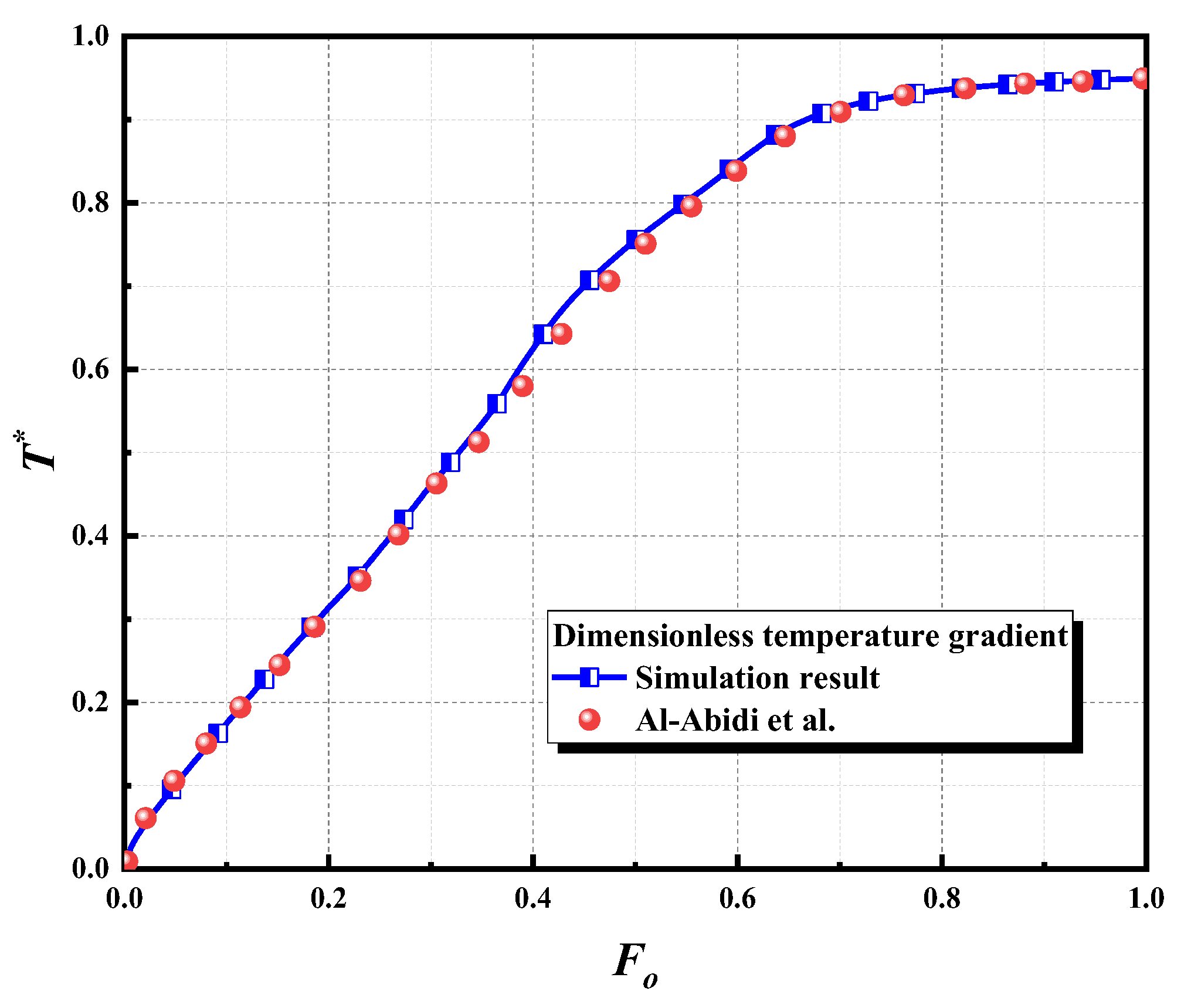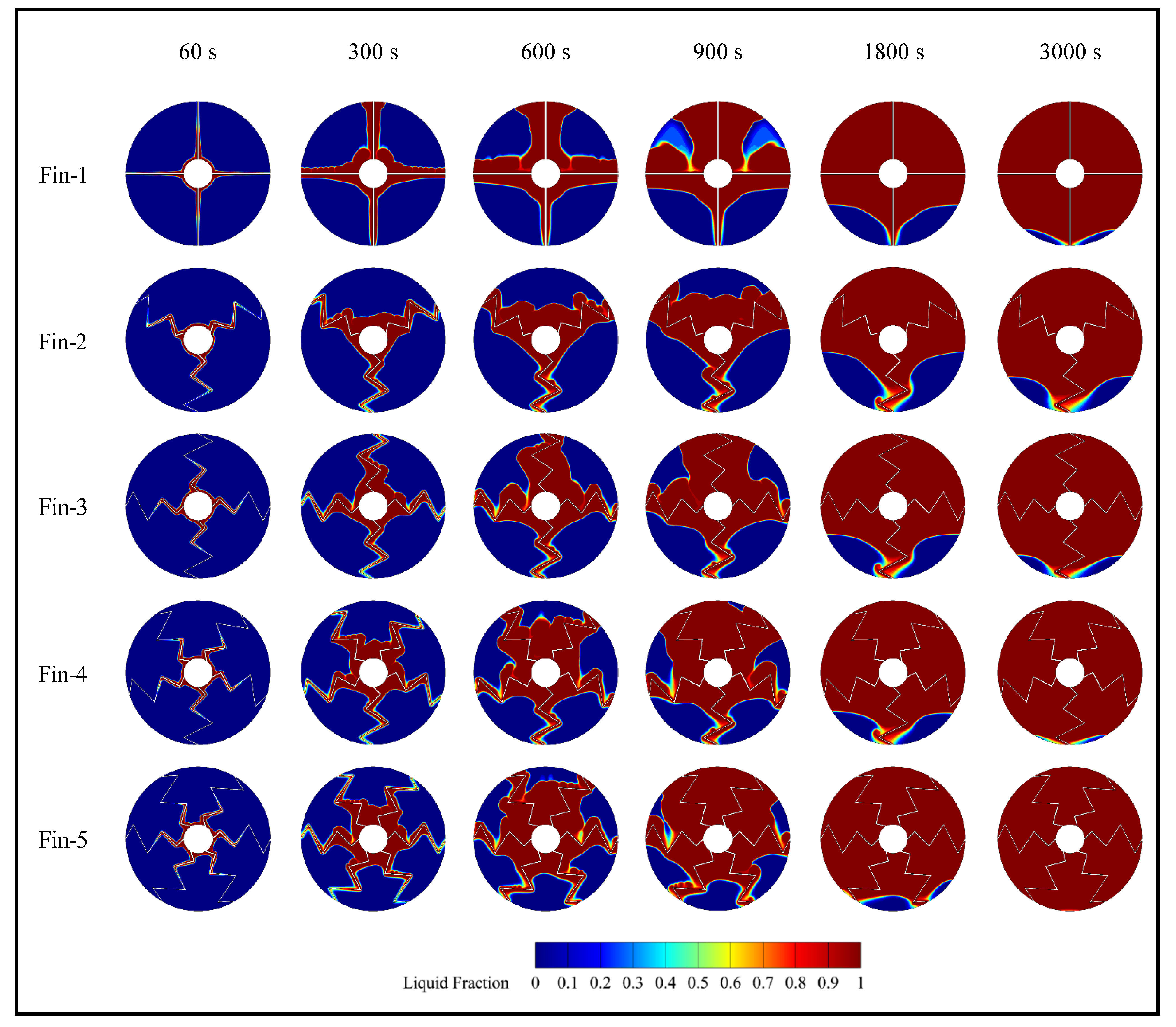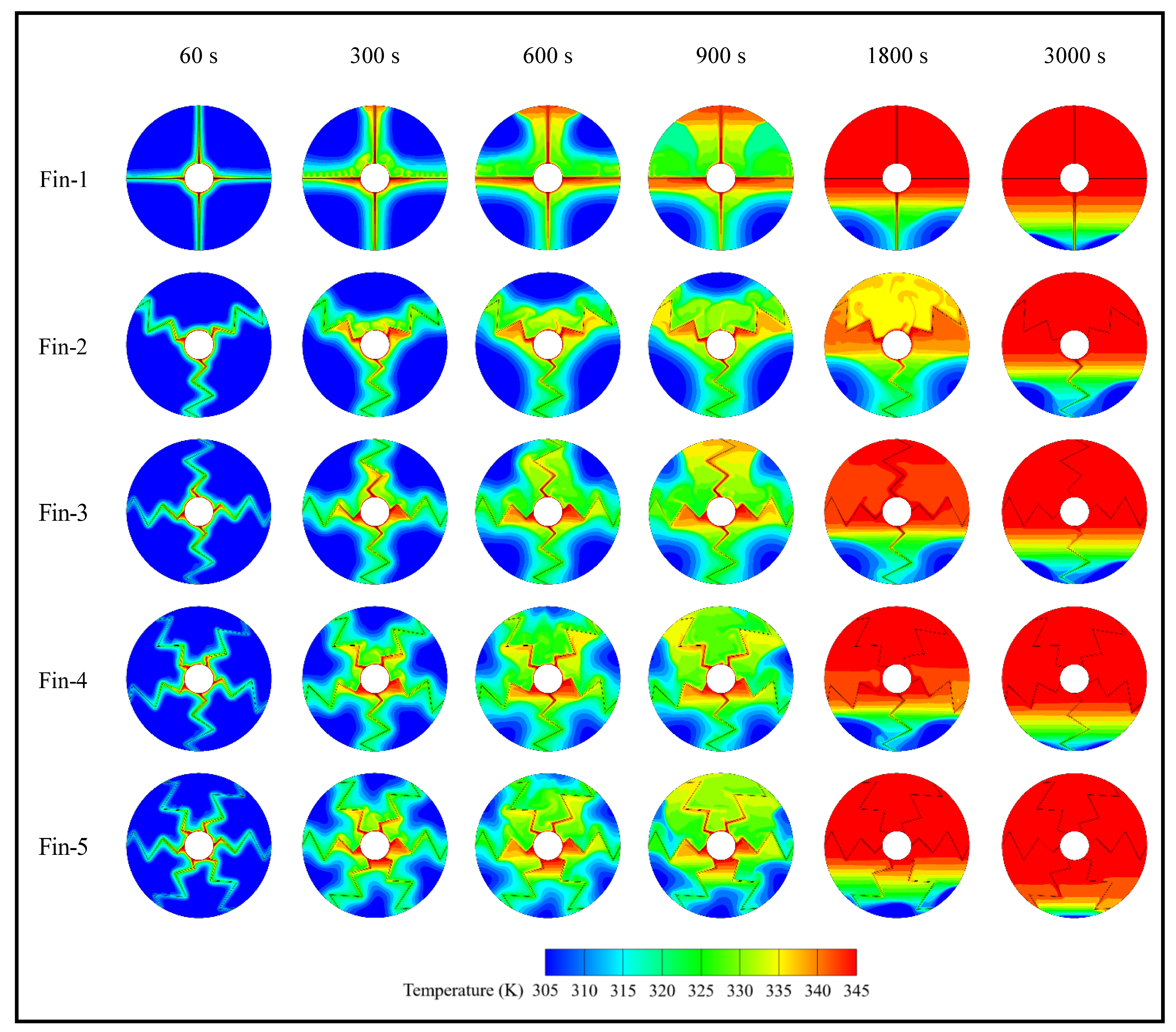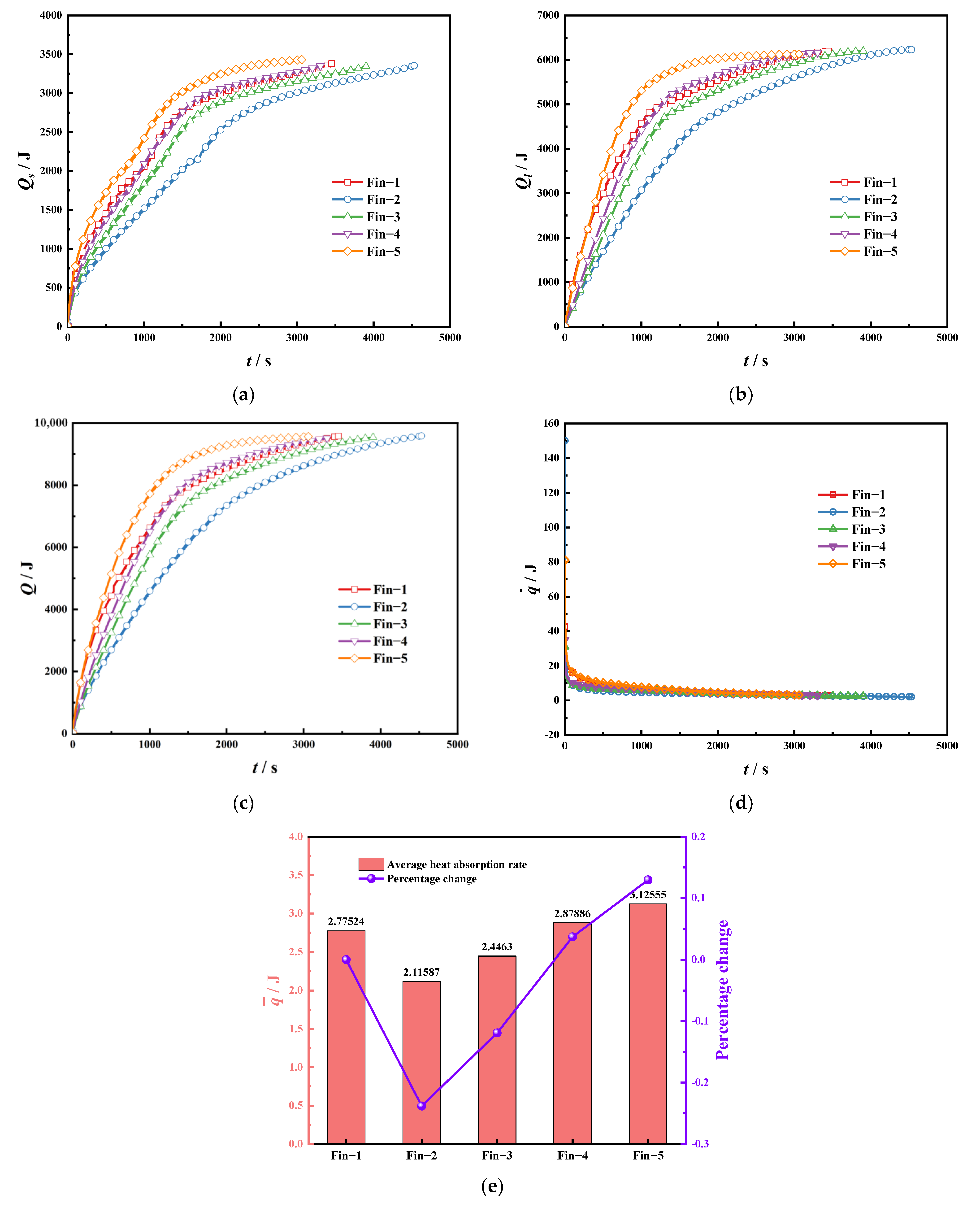Design and Research of Heat Storage Enhancement by Innovative Wave Fin in a Hot Water–Oil-Displacement System
Abstract
:1. Introduction
2. Model Description
2.1. Physical Model
2.2. Mathematical Model
- (1)
- Liquid PCM exhibits incompressible Newtonian laminar flow;
- (2)
- The Boussinesq hypothesis is employed to describe the generation of natural convection;
- (3)
- The PCM thermophysical properties are independent of temperature;
- (4)
- There is no heat exchange between the LHTES unit and the external environment.
2.3. Initial and Boundary Conditions
3. Numerical Method and Model Validation
3.1. Meshing and Numerical Processes
3.2. Grid Independence and Time Step Study
3.3. Model Validation
4. Results and Discussion
4.1. Comparison of Melting Process
4.2. Study of Liquid Phase Rate Parameters
4.3. Study on Heat Storage Parameters
4.4. Study of Temperature Response
5. Conclusions
- (1)
- Compared with the traditional rectangular fin, the wavy fin needs a longer heating time during the melting process, but it mitigates the negative effects caused by the refractory zone at the end of the melting phase;
- (2)
- The wavy fin number has a significant effect on its performance. The charging time of six wavy fins is 11.45% lower than rectangular fins, and the charging time is 32.56% lower than three wavy fins;
- (3)
- The number of wavy fins has a certain effect on the PCM volume in the LHTES unit, but the heat absorption change within a melting cycle is almost negligible. The average heat storage rate of five and six wavy fins is 3.70% and 12.98% higher than that of conventional rectangular fins, respectively;
- (4)
- The instantaneous temperature response of the LHTES unit corresponding to different fin structures all increased rapidly to the highest point at the beginning and gradually decreased. The average temperature response of six wavy fins is 17.78% higher than that of conventional rectangular fins.
- (5)
- This study only considers the number of three to six wavy fins, and further expansion of the number of fins is also worth studying. At the same time, the research on the solidification process of the phase change heat storage unit with the novel fin is also worth exploring.
Author Contributions
Funding
Data Availability Statement
Conflicts of Interest
Nomenclature
| Abbreviation | |
| LHTES | Latent Heat Thermal Energy Storage |
| PCM | Phase Change Material |
| HTF | heat transfer fluid |
| Symbols | |
| R1 | Isobaric specific heat |
| R2 | Thermal conductivity |
| Li | Longitudinal height of fins |
| di | Transverse width of the fin |
| k | Thermal conductivity |
| cp | Isobaric specific heat |
| Tm | Melting temperature |
| Ts | Solidus temperature |
| Tl | Liquidus temperature |
| Amush | Velocity momentum in the paste region |
| A decimal that prevents the equation denominator from being 0 | |
| fm | PCM liquid fraction |
| Melting rate | |
| h | Total enthalpy |
| Qs | Sensible heat absorption |
| Ql | Latent heat absorption |
| Q | Total heat absorption |
| Instantaneous rate of thermal absorption | |
| Average rate of thermal absorption | |
| Instantaneous temperature response rate | |
| Average temperature response rate | |
| Time at any moment | |
| Whole melting time | |
| Greek symbols | |
| μ | Dynamic viscosity |
| ρ | Density |
| λ | Latent heat of fusion |
| β | Volumetric coefficient of thermal expansion |
| Ω | Contact thermal transfer interface |
| Subscripts | |
| fin | Area of fins |
| pcm | Area of PCM |
| i | Initial |
| w | The wall |
References
- European Association for Storage of Energy. Thermal Storage Position Paper. 2017. Available online: http://ease-storage.eu/wp-content/uploads/2017/07/2017.07.10_EASE-Thermal-Storage-Position-Paper__for-distribution.pdf (accessed on 30 April 2020).
- He, Q.; Tapia, F.; Reith, A. Quantifying the influence of nature-based solutions on building cooling and heating energy demand: A climate specific review. Renew. Sustain. Energy Rev. 2023, 186, 113660. [Google Scholar] [CrossRef]
- Lupoae, O.-D.; Radu, R.I.; Capatina, A.; Isai, V.M.; Bărbuță-Mișu, N. Exploring Precursors of Renewable Energy Portfolio Diversification Using TPB. Energies 2023, 16, 6714. [Google Scholar] [CrossRef]
- Rahman, M.M.; Oni, A.O.; Gemechu, E.; Kumar, A. Assessment of energy storage technologies: A review. Energy Convers. Manag. 2020, 223, 113295. [Google Scholar] [CrossRef]
- Rui, S.; Guo, Z.; Zhou, W. Promoting Sustainable Marine Development: Geotechnical Engineering Problems and Environmental Guarantee Technology in Marine Space, Energy, and Resource Development. Sustainability 2023, 15, 14424. [Google Scholar] [CrossRef]
- Güneş, H.; Simba, H.M.A.; Karadağ, H.; Şit, M. Global Energy Transformation and the Impacts of Systematic Energy Change Policy on Climate Change Mitigation. Sustainability 2023, 15, 14298. [Google Scholar] [CrossRef]
- Pathak, S.K.; Tazmeen, T.; Chopra, K.; Tyagi, V.V.; Anand, S.; Abdulateef, A.M.; Pandey, A.K. Sustainable Energy Progress via Integration of Thermal Energy Storage and Other Performance Enhancement Strategies in FPCs: A Synergistic Review. Sustainability 2023, 15, 13749. [Google Scholar] [CrossRef]
- Guo, Z.; Zhou, W.; Liu, S.; Kang, Z.; Tan, R. Effects of Geometric Parameters and Heat-Transfer Fluid Injection Direction on Enhanced Phase-Change Energy Storage in Vertical Shell-and-Tube System. Sustainability 2023, 15, 13062. [Google Scholar] [CrossRef]
- Miao, A.; Yuan, Y.; Huang, Y.; Wu, H.; Feng, C. Stochastic Optimization Model of Capacity Configuration for Integrated Energy Production System Considering Source-Load Uncertainty. Sustainability 2023, 15, 14247. [Google Scholar] [CrossRef]
- Yin, Z.; Zheng, J.; Kim, H.; Seo, Y.; Linga, P. Hydrates for cold energy storage and transport: A review. Adv. Appl. Energy 2021, 2, 100022. [Google Scholar] [CrossRef]
- Huang, X.; Li, F.; Li, Y.; Meng, X.; Yang, X.; Sundén, B. Optimization of melting performance of a heat storage tank under rotation conditions: Based on taguchi design and response surface method. Energy 2023, 271, 127100. [Google Scholar] [CrossRef]
- Cui, P.; Yang, W.; Zhang, W.; Zhu, K.; Spitler, J.D.; Yu, M. Advances in ground heat exchangers for space heating and cooling: Review and perspectives. Energy Built Environ. 2024, 5, 255–269. [Google Scholar] [CrossRef]
- Zhang, C.; Huang, Y.; Chen, Y. Bionic study on latent heat thermal storage. Renew. Sustain. Energy Rev. 2023, 183, 113529. [Google Scholar] [CrossRef]
- Shank, K.; Tiari, S. A Review on Active Heat Transfer Enhancement Techniques within Latent Heat Thermal Energy Storage Systems. Energies 2023, 16, 4165. [Google Scholar] [CrossRef]
- Cui, W.; Si, T.; Li, X.; Li, X.; Lu, L.; Ma, T.; Wang, Q. Heat transfer enhancement of phase change materials embedded with metal foam for thermal energy storage: A review. Renew. Sustain. Energy Rev. 2022, 169, 112912. [Google Scholar] [CrossRef]
- Najim, F.T.; Bahlekeh, A.; Mohammed, H.I.; Dulaimi, A.; Abed, A.M.; Ibrahem, R.K.; Al-Qrimli, F.A.; Mahmoud, M.Z.; Awrejcewicz, J.; Pawłowski, W. Evaluation of Melting Mechanism and Natural Convection Effect in a Triplex Tube Heat Storage System with a Novel Fin Arrangement. Sustainability 2022, 14, 10982. [Google Scholar] [CrossRef]
- Khodadadi, J.; Hosseinizadeh, S. Nanoparticle-enhanced phase change materials (NEPCM) with great potential for improved thermal energy storage. Int. Commun. Heat Mass Transf. 2007, 34, 534–543. [Google Scholar] [CrossRef]
- Mahdi, J.M.; Nsofor, E.C. Solidification enhancement of PCM in a triplex-tube thermal energy storage system with nanoparticles and fins. Appl. Energy 2018, 211, 975–986. [Google Scholar] [CrossRef]
- Cabeza, L.F.; Navarro, L.; Pisello, A.L.; Olivieri, L.; Bartolomé, C.; Sánchez, J.; Álvarez, S.; Tenorio, J.A. Behaviour of a concrete wall containing micro-encapsulated PCM after a decade of its construction. Sol. Energy 2020, 200, 108–113. [Google Scholar] [CrossRef]
- Mlakar, U.; Zavrl, E.; Stritih, U. An experimental and numerical analysis of an improved thermal storage tank with encapsulated PCM for use in retrofitted buildings for heating. Energy Build. 2021, 248, 111196. [Google Scholar]
- Abdulateef, A.M.; Mat, S.; Abdulateef, J.; Sopian, K.; Al-Abidi, A.A. Geometric and design parameters of fins employed for enhancing thermal energy storage systems: A review. Renew. Sustain. Energy Rev. 2018, 82, 1620–1635. [Google Scholar] [CrossRef]
- Kumar, R.; Verma, P. An experimental and numerical study on effect of longitudinal finned tube eccentric configuration on melting behaviour of lauric acid in a horizontal tube-in-shell storage unit. J. Energy Storage 2020, 30, 101396. [Google Scholar] [CrossRef]
- Li, Z.-R.; Fu, G.-T.; Fan, L.-W. Synergistic effects of nano-enhanced phase change material (NePCM) and fin shape on heat storage performance of a finned shell-and-tube unit: An experimental study. J. Energy Storage 2022, 45, 103772. [Google Scholar] [CrossRef]
- Zhang, S.; Pu, L.; Xu, L.; Liu, R.; Li, Y. Melting performance analysis of phase change materials in different finned thermal energy storage. Appl. Therm. Eng. 2020, 176, 115425. [Google Scholar] [CrossRef]
- Huang, Y.; Deng, Z.; Chen, Y.; Zhang, C. Performance investigation of a biomimetic latent heat thermal energy storage device for waste heat recovery in data centers. Appl. Energy 2023, 335, 120745. [Google Scholar] [CrossRef]
- Hosseinzadeh, K.; Montazer, E.; Shafii, M.B.; Ganji, A.R.D. Solidification enhancement in triplex thermal energy storage system via triplets fins configuration and hybrid nanoparticles. J. Energy Storage 2021, 34, 102177. [Google Scholar] [CrossRef]
- Huang, X.; Yao, S.; Yang, X.; Zhou, R. Melting performance assessments on a triplex-tube thermal energy storage system: Optimization based on response surface method with natural convection. Renew. Energy 2022, 188, 890–910. [Google Scholar] [CrossRef]
- Modi, N.; Wang, X.; Negnevitsky, M. Experimental investigation of the effects of inclination, fin height, and perforation on the thermal performance of a longitudinal finned latent heat thermal energy storage. Energy 2023, 274, 127327. [Google Scholar] [CrossRef]
- Ma, J.; Xu, H.; Liu, S.; Peng, H.; Ling, X. Numerical study on solidification behavior and exergy analysis of a latent heat storage unit with innovative circular superimposed longitudinal fins. Int. J. Heat Mass Transf. 2021, 169, 120949. [Google Scholar] [CrossRef]
- Eslami, M.; Khosravi, F.; Kohan, H.F. Effects of fin parameters on performance of latent heat thermal energy storage systems: A comprehensive review. Sustain. Energy Technol. Assess. 2021, 47, 101449. [Google Scholar] [CrossRef]
- Zhang, S.; Mancin, S.; Pu, L. A review and prospective of fin design to improve heat transfer performance of latent thermal energy storage. J. Energy Storage 2023, 62, 106825. [Google Scholar] [CrossRef]
- Modi, N.; Wang, X.; Negnevitsky, M. Melting and solidification characteristics of a semi-rotational eccentric tube horizontal latent heat thermal energy storage. Appl. Therm. Eng. 2022, 214, 118812. [Google Scholar] [CrossRef]
- Al-Abidi, A.A.; Mat, S.; Sopian, K.; Sulaiman, M.Y.; Mohammad, A.T. Experimental study of PCM melting in triplex tube thermal energy storage for liquid desiccant air conditioning system. Energy Build. 2013, 60, 270–279. [Google Scholar] [CrossRef]
- Liu, Y.; Sun, L.; Zheng, J.-n.; Yang, L.; Jiang, L.; Song, Y. Numerical simulation study of the phase transition heat transfer of nanoparticle-enhanced heat storage tubes. Appl. Therm. Eng. 2023, 231, 121010. [Google Scholar] [CrossRef]
- Safari, V.; Kamkari, B.; Hooman, K.; Khodadadi, J.M. Sensitivity analysis of design parameters for melting process of lauric acid in the vertically and horizontally oriented rectangular thermal storage units. Energy 2022, 255, 124521. [Google Scholar] [CrossRef]
- Singh, V.K.; Patel, A. Effect of mushy zone constant on the melting of a solid-liquid PCM under hyper-gravity conditions. Int. Commun. Heat Mass Transf. 2022, 134, 105993. [Google Scholar] [CrossRef]
- Zhuang, Y.; Li, H.; Xu, W.; Huang, S.-M. Experimental study on the melting performance of magnetic NEPCMs embedded in metal foam subjected to a non-uniform magnetic field. Sol. Energy Mater. Sol. Cells 2023, 250, 112077. [Google Scholar] [CrossRef]
- Huang, Y.; Yao, F.; Liu, X. Numerical study on the thermal enhancement of horizontal latent heat storage units with hierarchical fins. Renew. Energy 2021, 180, 383–397. [Google Scholar] [CrossRef]
- Zaib, A.; Mazhar, A.R.; Aziz, S.; Talha, T.; Jung, D.-W. Heat Transfer Augmentation Using Duplex and Triplex Tube Phase Change Material (PCM) Heat Exchanger Configurations. Energies 2023, 16, 4037. [Google Scholar] [CrossRef]
- Al-Abidi, A.A.; Mat, S.; Sopian, K.; Sulaiman, M.Y.; Mohammad, A.T. Experimental study of melting and solidification of PCM in a triplex tube heat exchanger with fins. Energy Build. 2014, 68, 33–41. [Google Scholar] [CrossRef]
- Zhang, Y.; Lu, B.; Wang, Z.; Zhu, J.; Zhang, J.; Wang, C. Experimental investigation on the charging and discharging performance enhancement of a vertical latent heat thermal energy storage unit via snowflake fin design. Int. J. Heat Mass Transf. 2022, 199, 123455. [Google Scholar] [CrossRef]










| Geometric Numbering | Numerical Value (mm) |
|---|---|
| R1 | 10 |
| R2 | 50 |
| L1 | 5 |
| L2 | 10 |
| L3 | 10 |
| L4 | 10 |
| L5 | 5 |
| d1 | 1 |
| d2 | 5 |
| d3 | 10 |
| Property | Paraffin RT50 | Paraffin RT82 | Cu | Unit |
|---|---|---|---|---|
| Thermal conductivity (k) | 0.2 | 0.2 | 387.6 | W/m·K |
| Dynamic viscosity (μ) | 0.0048 | 0.03499 | Pa·s | |
| Isobaric specific heat (cp) | 2000 | 2000 | 381 | J/kg·K |
| Density (ρ) | 760 (liq) 880(sol) | 770 (liq) 950(sol) | 8978 | kg/m3 |
| Melting temperature (Tm) | 321.15 | 353.15 | K | |
| Latent heat of fusion (λ) | 168000 | 176000 | J/kg | |
| Volumetric coefficient of thermal expansion (β) | 0.0006 | 0.001 | K−1 | |
| Solidus temperature (Ts) | 318.15 | 351.15 | K | |
| Liquidus temperature (Tl) | 324.15 | 355.15 | K |
| Total Sensible Heat Energy | Total Latent Heat Energy | Total Heat Energy | |
|---|---|---|---|
| Fin-1 | 3378.73231 | 6195.83858 | 9574.57088 |
| Fin-2 | 3355.46861 | 6229.44 | 9584.90861 |
| Fin-3 | 3344.71704 | 6195.83833 | 9540.55537 |
| Fin-4 | 3349.51248 | 6162.23917 | 9511.75165 |
| Fin-5 | 3432.41211 | 6128.63745 | 9561.04956 |
Disclaimer/Publisher’s Note: The statements, opinions and data contained in all publications are solely those of the individual author(s) and contributor(s) and not of MDPI and/or the editor(s). MDPI and/or the editor(s) disclaim responsibility for any injury to people or property resulting from any ideas, methods, instructions or products referred to in the content. |
© 2023 by the authors. Licensee MDPI, Basel, Switzerland. This article is an open access article distributed under the terms and conditions of the Creative Commons Attribution (CC BY) license (https://creativecommons.org/licenses/by/4.0/).
Share and Cite
Ning, T.; Huang, X.; Su, J.; Yang, X. Design and Research of Heat Storage Enhancement by Innovative Wave Fin in a Hot Water–Oil-Displacement System. Sustainability 2023, 15, 15785. https://doi.org/10.3390/su152215785
Ning T, Huang X, Su J, Yang X. Design and Research of Heat Storage Enhancement by Innovative Wave Fin in a Hot Water–Oil-Displacement System. Sustainability. 2023; 15(22):15785. https://doi.org/10.3390/su152215785
Chicago/Turabian StyleNing, Tao, Xinyu Huang, Junwei Su, and Xiaohu Yang. 2023. "Design and Research of Heat Storage Enhancement by Innovative Wave Fin in a Hot Water–Oil-Displacement System" Sustainability 15, no. 22: 15785. https://doi.org/10.3390/su152215785






